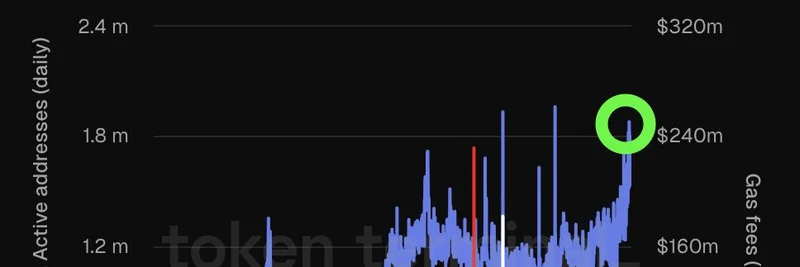Ethereum is making waves again, folks. According to a recent post from Token Terminal, the Ethereum mainnet—often called L1 for Layer 1—is buzzing with record-breaking activity. Transactions and active addresses are at their highest points ever, but here's the kicker: gas fees are dipping close to all-time lows. This is huge for the crypto world, especially if you're into meme tokens, which thrive on fast, cheap trades.
Let's break this down simply. Ethereum L1 is the core blockchain where everything started—think of it as the foundation layer for smart contracts, DeFi, NFTs, and yes, those viral meme coins. Transactions refer to the daily number of actions happening on the chain, like sending ETH or swapping tokens. Active addresses are the unique wallets interacting with the network each day, a solid gauge of user engagement. And gas fees? That's the cost you pay to process those transactions, measured here in total daily USD value.
From the chart shared in the original tweet, you can see transactions (blue line) and active addresses (black line) spiking upward, especially in recent years, hitting around 2.4 million and 1.8 million daily, respectively. Meanwhile, the red line for gas fees has been on a rollercoaster but is now hovering near historic lows, down to about $80 million daily after peaks over $240 million.
Why is this happening? It's largely thanks to Ethereum's ongoing upgrades. The Dencun hard fork in early 2024 introduced proto-danksharding and data blobs (via EIP-4844), which made posting data from Layer 2 (L2) solutions way cheaper. L2s like Optimism, Arbitrum, and Base are rollups that bundle transactions off-chain and settle them on L1, boosting scalability. This means more activity can flow through without jacking up fees on the mainnet. As a result, Ethereum is handling more users and trades than ever, but the costs are staying manageable.
Implications for Meme Tokens
Now, let's talk about what this means for meme tokens—the fun, speculative side of crypto that Meme Insider loves to cover. Meme coins like Dogecoin or newer ones on Ethereum L2s (think PEPE or SHIB variants) often rely on hype-driven trading. High gas fees used to be a buzzkill, making small trades expensive and turning away retail investors. But with fees plummeting, it's easier for everyone to jump in.
For instance, on Base—an Ethereum L2 that's exploded with meme activity—low costs have fueled massive trading volumes. Ethereum's L1 improvements indirectly supercharge these L2s by keeping the settlement layer efficient. More active addresses on L1 signal broader adoption, which trickles down to meme ecosystems. Developers can launch new tokens, communities can trade without breaking the bank, and the whole scene gets more vibrant.
Broader Crypto Ecosystem Benefits
This scaling success isn't just about memes; it's a win for the entire Web3 space. DeFi protocols can operate smoother, NFT marketplaces see more flips, and even enterprise apps might find Ethereum more appealing. As we head deeper into 2025, keep an eye on upcoming upgrades like Prague/Electra, which could push things further with features like Verkle trees for better node efficiency.
If you're a blockchain practitioner, this data underscores the importance of staying updated on layer solutions. Tools like Token Terminal provide invaluable insights—check them out for real-time metrics.
In short, Ethereum's not slowing down; it's evolving. Lower fees plus higher activity? That's the recipe for a thriving meme token landscape and beyond. What do you think—will this spark the next meme coin bull run? Drop your thoughts in the comments!



